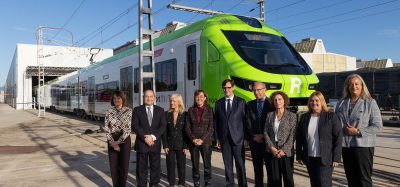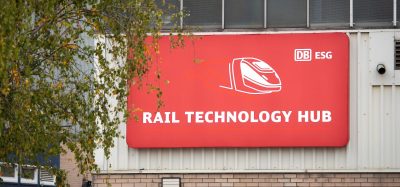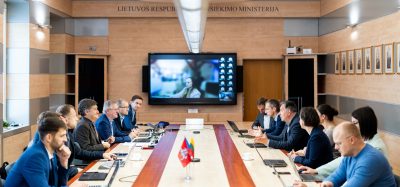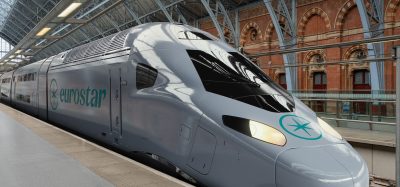Innovative trainsets for cross-border traffic
Posted: 14 February 2006 | | No comments yet
The German railway industry has long been considered a world leader with its innovative products. This also underscores the economic success in a generally difficult market. During the first half of 2005, the German rolling stock industry delivered more than half of its vehicles to foreign customers. Siemens’ innovative vigor has always provided decisive impetus […]
The German railway industry has long been considered a world leader with its innovative products. This also underscores the economic success in a generally difficult market. During the first half of 2005, the German rolling stock industry delivered more than half of its vehicles to foreign customers.
Siemens’ innovative vigor has always provided decisive impetus for the worldwide development of railway traffic. The Transportation Systems Group with its Automation & Power, Rolling Stock, Turnkey Systems and Integrated Services segments has not only developed into one of the largest vendors in the global railway industry since its formation in 1989, but also successfully offers a complete portfolio of expertise for operations control systems ranging from railway electrification to rolling stock for mass transit, regional and main-line traffic, including comprehensive experience in project management and forward-looking service concepts as a single-source supplier. The development of modern trainsets has become increasingly focused on cross-border interoperability. Siemens Transportation Systems has once again proven its innovative energy in 2005 with future-oriented vehicle concepts.
Velaro – a high-speed trainset not only for Europe
Cities, regions and countries in a united Europe continue to grow closer together. Distances increasingly play a secondary role, while mobility is becoming increasingly more important. European railways have re-written the rules for competition with the other carriers by creating a network of high-speed lines. Siemens Transportation Systems made a substantial contribution to this development. The three previous generations of the German ICE high-speed trains were born alone under the participation and leadership of Siemens. Now is the time to link the national high-speed networks to each other and to roll out a trainset family capable of operating throughout a Europe without borders, as already exists in the form of the multi-system-capable ICE 3. As various ICE types have been used in cross-border traffic to Austria and Switzerland in the past, the multi-system ICE 3 has meanwhile been approved in Germany, Belgium, The Netherlands and Switzerland. Five existing trainsets of the Class 406 series are now being equipped for service on the Frankfurt/M-Saarbrücken-Paris line, as part of the German-French POS (Paris-Eastern France-Southern Germany) transport project. This includes the integration of French train control systems, preparation work for the integration of ETCS and reconciliation with specific French requirements related to certification and operation. Operation of this trans-European line is planned to start in summer 2007.
Siemens Transportation Systems set a new milestone for European compliance with the development of the Velaro trainset platform – based on the successful ICE 3 trainset concept used by German Railways. Designed for a top speed of 350km/h, this trainset generation satisfies all standards in the Technical Specifications for Interoperability (TSI standards). In line with the unproblematic integration of European train safety and communication systems, the trainsets are also prepared for future deployment on lines equipped with the pan-European standardised European Train Control System (ETCS).
The Velaro platform is based purely on a multiple-unit concept, which distributes the drives and all technical modules under the floor throughout the train. This means that the entire interior length of the train is available for passenger accommodation. This results in a space increase compared to earlier trainsets of 20%, offering the benefit of a higher passenger capacity and/or improved comfort. The evenly distributed weight over the whole train also improves running properties and, in turn, passenger comfort. At the same time, this enables the axle load to be reduced below the internationally specified value of a maximum of 17 metric tons, with benefits for the track. High utilisation of the adhesion coefficient is achieved during acceleration and electrical braking with 50% of the axles being driven. This traction concept also allows track sections to be negotiated with gradients as steep as 4%. The choice of a train length of 200 metres in accordance with the TSI standards allows double heading and thus opens up the possibility of forming multi-section trains to satisfy demands.
The Velaro E introduced in Spain during the summer of 2005 is currently attracting keen attention. Siemens is delivering 26 high-speed AVE S 103 trains to the Spanish National Railways (RENFE) and is taking over their maintenance for a period of 14 years. The 8-car sets will initially operate on the 625 kilometre line from Barcelona via Saragossa to Madrid and will reduce the travel time between the two cities to less than two and a half hours. The trainsets provide 404 seats in the three classes; Club, Preferente (Preferred) and Turista (Tourist) to satisfy customers even with the highest comfort expectations. The last car at the front end of the train accommodates the Club class with conference and VIP facilities and a separate galley. The neighbouring Preferente class offers high-quality furnishings and individual service at Business class level. The cafeteria car forms the transition to the Tourist class, where space is available for a customer service center, train staff and unaccompanied baggage.
Almost all seats in the Velaro E are pivot-mounted and can thus be rotated to suit the direction of travel before starting the trip. All car classes offer entertainment programs on large video displays. Six different audio programs in stereo quality can also be received at all seats. LED interior and exterior displays cater for continuously updated passenger information. A redundant air-conditioning system with boosted performance for operation at outdoor temperatures of up to 50°C ensures comfortable climatisation.
Scheduled to enter operation on the 25 kV 50 Hz AC electrified high-speed line, starting in early 2007, the AVE S 103s are equipped with 10% more traction power (8800 kilowatt) than the German ICE 3 trains. Four independent traction units and low-maintenance three-phase asynchronous motors ensure high availability.
The Velaro platform enables Siemens to follow the adopted approach of offering high-speed trains consistently as a single-source manufacturer. The ever increasing interest shown by many railway operators confirms that this is the right decision. For example, Siemens Transportation Systems is developing a broad-gauge version of the Velaro under a development contract awarded by Russian Railways (RZD) in spring 2005 and will also build 60 high-speed trains for China together with its Chinese partner company Tangshan Locomotive & Rolling Stock Works.
A new Desiro generation
The development of a new generation of weight-optimised, cheaper and more easily maintained multiple-unit trains led to a virtual renaissance of urban rail transportation in Germany in the 1990s. Siemens Transportation Systems played a decisive role in this with the Desiro family of multiple units. The modular vehicle concept covers the gamut from modern commuter trains to vehicles for regional rail operations and feeders for long-distance traffic. The multiple-unit platform has been continuously adapted to meet increasing market and passenger demands.
Since customers have purchased more than 500 Desiro Classic units – the diesel version in Europe and North America and the electric railcar version in Slovenia and Greece – in the past five years, Siemens is now introducing a further development, the Desiro Mainline. The new Desiro generation represents a flexible and versatile vehicle platform with a maximum speed of 160km/h. The Desiro Mainline permits different train configurations and individual layouts that ensure an optimal match to the operations concept. The offer includes two- to five-car single units with electric or diesel-electric traction, which can also be re-equipped flexibly to suit changing operational conditions during their service life. The different floor heights of 600/800/1000 millimetres are just as available as different door and entry concepts. The multiple units that are designed for different overhead line voltages can be operated in configurations with up to four units. The design of the trains developed further from the Desiro Classic conforms to, among other things, the latest standards for fire prevention and crashworthiness.
At the beginning of 2003, Swiss Federal Railways (SBB) was the first railway administration to place an order with Siemens Switzerland for 35 Desiro type RABe 514 double-deck electric multiple units as part of its program to further expand the rapid transit system in the Greater Zurich area. The four-car sets will supplement the 185 commuter trains currently operating on the 380 track kilometres of Zurich’s 24-line rapid transit system. These 140km/h multiple units are fully air-conditioned and fitted with vacuum toilets ensuring elderly and handicapped accessibility. Eight twin-leaf swing-plug sliding doors located in the low-floor area allow fast boarding and exiting also for passengers with reduced mobility. The cars come with extendible door steps that bridge the gap between the train and the platform. One car in each unit contains a multi-purpose compartment on the lower deck for travelers with baby carriages or bicycles and for passengers in wheelchairs interior doors have been avoided to a large extent. Passengers are able to walk from end-to-end in the four-car train and its total length is 100 metres and offers seats for 396 passengers and standing room for more than 600. The seating formation is a 2+2 layout with a central aisle and is suspended from the side walls using a cantilever structure that eliminates the need for supporting legs to simplify cleaning.
The car bodyshell is a separate frame construction made of steel. The traction units are based on modern IGBT technology and are installed in the two end cars. The asynchronous traction motors on the four powered bogies are each fed by one IGBT inverter. A maximum power rating of 3200 kilowatts at the wheel rim guarantees quick performance on the heavily traveled lines with their short distances between stations. The technical safety equipment includes the classic Swiss Integra train control system and the newly developed ZUB 262 C. Provision has been made for the installation of an ETCS device.
After the presentation of the first multiple-unit train in Zurich central train station on 2 December 2005, the first double-deckers are due to enter regular passenger service in summer 2006. With their light-coloured livery of red front and blue stripes and attractive design of the Desiro family, these trains will set the tone and new appearance of Zurich’s rapid transit system. After initial trials on less heavily traveled lines, they will later operate in conjunction with existing DPZ Re 450 commuter trains.
Innovation of the Desiro UK platform for the global market
Siemens Transportation Systems expanded its product portfolio with the new Desiro UK multiple unit family with an aluminum structure to satisfy the requirements of the British mass transit market.
After successfully entering the privatised British market in 1998 with the delivery of 14 multiple units for the Heathrow Airport Express, Siemens has been able to win contracts for a total of 1,200 cars. More than 200 trains of the Desiro UK platform generation have run over 30 million miles in passenger operation and are considered to be the most reliable vehicles in the English railway system.
The cars are available in different basic variants in order to satisfy differing operator requirements. The trains can consist of 3-, 4-, 5- or 6-car units, whereby differing car lengths of 20m or 23m offer additional flexibility.
The vehicles are designed for the 750 V DC network or, as dual-system vehicles, also for operation on 25 kV 50 Hz lines.
A modular vehicle design will guarantee the use of the same components in different contracts. The vehicle concept fulfils the increasing demands for comfort and safety of passengers and private operators, especially with full air-conditioning, vacuum toilets and modern monitoring and passenger information systems.
The approval process and safety verification (Safety Case) was regulated by law when English railway transportation was privatised. These new processes influenced the design of the electrical systems and the control technology of Desiro UK with the objective of minimising network perturbations and to guarantee safe operation also in fault situations. The trains also comply with the latest fire prevention and crash safety requirements.
Overview of Desiro UK basic variants
The dimensions and all spaces in the under-floor area were defined for the maximum equipment as 20m dual-system vehicles. The installation recesses for components that are not needed for the single-system vehicle (25 kV AC or 750 V DC) remain empty. The tighter lateral boundaries in the UK profile of the 23m vehicle were also taken into consideration in the 20m vehicle. The longer car body of the 23m vehicle ensures a virtually identical layout of the large components.
The design of one vehicle family for different voltage supplies could thus be achieved in a simple but effective manner.
The concepts are structured in such a manner that they accommodate the design of trains with varying numbers of cars. To achieve this, cars are added and the necessary additional equipment fitted. The end cars remain unchanged, whereby two variants are provided: with or without front-end access doors.
In the meantime, this successful cooperation with English customers has resulted in the expansion of the Desiro UK platform to include diesel traction units.
The modular concept, of course, also permits international use of the vehicles outside Great Britain.
Stay Connected with Global Railway Review — Subscribe for Free!
Get exclusive access to the latest rail industry insights from Global Railway Review — all tailored to your interests.
✅ Expert-Led Webinars – Gain insights from global industry leaders
✅ Weekly News & Reports – Rail project updates, thought leadership, and exclusive interviews
✅ Partner Innovations – Discover cutting-edge rail technologies
✅ Print/Digital Magazine – Enjoy two in-depth issues per year, packed with expert content
Choose the updates that matter most to you. Sign up now to stay informed, inspired, and connected — all for free!
Thank you for being part of our community. Let’s keep shaping the future of rail together!







